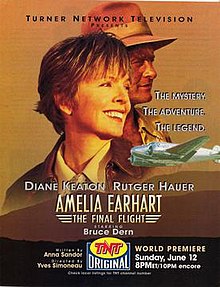Amelia Earhart: The Final Flight
| Amelia Earhart: The Final Flight | |
|---|---|

Print advertisement
|
|
| Directed by | Yves Simoneau |
| Produced by | Cary Brokaw (producer) Joseph J. Kelly (co-producer) Randy Robinson (executive producer) Gordon Wolf (line producer) |
| Written by | Doris L. Rich (writer) Anna Sandor (screenwriter) |
| Starring |
Diane Keaton Rutger Hauer Bruce Dern |
| Music by | George S. Clinton |
| Cinematography | Lauro Escorel |
| Edited by | Michael D. Ornstein |
|
Production
company |
Avenue Pictures Productions
|
| Distributed by | Turner Network Television (TNT) |
|
Release date
|
June 12, 1994 |
|
Running time
|
95 minutes |
| Country | United States |
| Language | English |
Amelia Earhart: The Final Flight (also known as Amelia Earhart) is a 1994 television film starring Diane Keaton, Rutger Hauer and Bruce Dern. It is based on Doris L. Rich's Amelia Earhart: A Biography. The film depicts events in the life of Amelia Earhart, focusing on her final flight and disappearance in 1937, with her exploits in aviation and her marriage to publisher G.P. Putnam being revealed in flashbacks. This film was not the first television dramatization of Earhart's life, as Amelia Earhart appeared in 1976, starring Susan Clark as Earhart and John Forsythe as her husband George Putnam.
In 1928, Amelia Earhart (Diane Keaton) gains fame by undertaking a transatlantic flight, albeit as a passenger. Her marriage to media tycoon George Palmer Putnam (Bruce Dern) and a series of record-breaking flights propel her to international fame as a long-distance flyer. With help from a close friend and adviser, Paul Mantz (Paul Guilfoyle), Earhart and her navigator, the hard-drinking Fred Noonan (Rutger Hauer), plan her longest flight ever: a round-the-world attempt in 1937. The interest in Japanese-held islands may lead to her disappearance, and a massive search effort is unsuccessful, but solidifies Earhart as an aviation icon.
As appearing in screen credits (main roles identified): Cast overview, first billed only:
Principal photography began on October 18, 1993 with studio work as well as location shooting in both California and Quebec. Although a Beech D18 was used, it was an adequate substitute for Earhart's famed Lockheed Model 10 Electra used in the circumnavigational flight of the globe in 1937. Well-known race pilot Steve Hinton, president of the Planes of Fame Air Museum and owner of Fighter Rebuilders, flew for the film. The cockpit section of the Beech aircraft used (actually the US Navy variant, an SNB-5) is now on display at Lyon Air Museum in Orange County, CA as part of a hands-on education area.
...
Wikipedia
